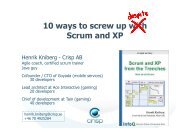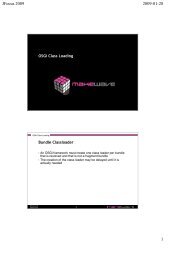A practical guide to mixing java EE and OSGi - Jfokus
A practical guide to mixing java EE and OSGi - Jfokus
A practical guide to mixing java EE and OSGi - Jfokus
Create successful ePaper yourself
Turn your PDF publications into a flip-book with our unique Google optimized e-Paper software.
Modular Java <strong>EE</strong><br />
in the cloud<br />
A <strong>practical</strong> <strong>guide</strong> <strong>to</strong> <strong>mixing</strong> <strong>java</strong> <strong>EE</strong> <strong>and</strong> <strong>OSGi</strong><br />
<strong>Jfokus</strong> 2013
Practical Guide <strong>to</strong><br />
Modularity in the<br />
Cloud Age<br />
<strong>Jfokus</strong> 2013
Bert Ertman<br />
Fellow at Luminis in the Netherl<strong>and</strong>s<br />
JUG Leader for NLJUG <strong>and</strong> a Java Champion<br />
@bertertman<br />
Paul Bakker<br />
Architect at Luminis Technologies<br />
@pbakker<br />
A presentation for
Trend<br />
Applications tend <strong>to</strong> grow bigger <strong>and</strong><br />
more complex<br />
Agile development <strong>and</strong> refac<strong>to</strong>ring<br />
have become more common
This leads <strong>to</strong> a number of challenges :<br />
Dependency<br />
Management<br />
Maintenance<br />
(long term)<br />
Versioning<br />
Deployment
Apps are moving <strong>to</strong> the cloud<br />
Cloud challenges require non-<br />
trivial non-functional<br />
requirements<br />
Zero-downtime deployments<br />
Modular deployments<br />
Cus<strong>to</strong>mer specific extensions<br />
(SaaS)
Modularity<br />
is the answer
But... what exactly is<br />
modularity?
What we learned about OO design in university :<br />
Prevent<br />
(tight)<br />
coupling<br />
Promote<br />
cohesion<br />
coupling<br />
cohesion
How <strong>to</strong> prevent<br />
coupling in a code<br />
base?
How <strong>to</strong> prevent<br />
coupling in a code<br />
base?<br />
interfaces
But how <strong>to</strong> make<br />
sure nobody<br />
accidentally uses<br />
implementation<br />
classes?
But how <strong>to</strong> make<br />
imp lemen tation<br />
sure nobody<br />
accidentally uses<br />
implementation<br />
hi di ng<br />
classes?
Modules
Ok, but how <strong>to</strong> create an<br />
instance of a hidden<br />
class?<br />
MyInterface myI = new<br />
MyImplementation();
Service Lookups
Design time<br />
modularity<br />
Divide <strong>and</strong> conquer<br />
Forces separation of concerns<br />
Prevents spaghetti
The jar file is the unit of<br />
runtime modularity<br />
on the Java platform<br />
What about<br />
classpath<br />
hell?
How <strong>to</strong> deal with<br />
Runtime dynamics<br />
Module versioning<br />
Updating single modules<br />
Intra-module dependency<br />
management
What do we need?<br />
design<br />
consequences<br />
High-level<br />
enterprise APIs<br />
Architectural<br />
focus on<br />
modularity<br />
let’s not<br />
reinvent the<br />
wheel<br />
Runtime<br />
dynamic<br />
module<br />
framework<br />
Right now,<br />
<strong>OSGi</strong> is the<br />
only option
<strong>OSGi</strong> is the de-fac<strong>to</strong><br />
st<strong>and</strong>ard module<br />
system for Java<br />
What about Jigsaw?<br />
<strong>OSGi</strong> != modularity
<strong>OSGi</strong> is the de-fac<strong>to</strong><br />
st<strong>and</strong>ard module<br />
system for Java<br />
What about Jigsaw?<br />
<strong>OSGi</strong> != modularity<br />
remember!<br />
Modularity is<br />
an architectural<br />
principle
<strong>OSGi</strong> is the de-fac<strong>to</strong><br />
st<strong>and</strong>ard module<br />
system for Java<br />
What about Jigsaw?<br />
<strong>OSGi</strong> != modularity<br />
remember!<br />
Modularity is<br />
an architectural<br />
principle<br />
Modularity<br />
does not come<br />
for free with a<br />
framework
Demo
<strong>OSGi</strong> vs. Java <strong>EE</strong>
Java <strong>EE</strong>:<br />
high level<br />
APIs<br />
<strong>OSGi</strong> vs. Java <strong>EE</strong> : opposite ends?<br />
<strong>OSGi</strong>:<br />
low-level, mix<br />
<strong>and</strong> match<br />
yourself
Java <strong>EE</strong>:<br />
high level<br />
APIs<br />
<strong>OSGi</strong> vs. Java <strong>EE</strong> : opposite ends?<br />
They don’t<br />
have <strong>to</strong> be<br />
either / or<br />
<strong>OSGi</strong>:<br />
low-level, mix<br />
<strong>and</strong> match<br />
yourself
How? - 3 options<br />
#1#2<br />
<strong>OSGi</strong> as core<br />
architecture with<br />
<strong>EE</strong> APIs published<br />
as services<br />
Hybrid solution<br />
using an<br />
injection bridge<br />
#3<br />
<strong>OSGi</strong> a la carte
Option 1 - <strong>OSGi</strong> in Java <strong>EE</strong> App Servers<br />
<strong>OSGi</strong> bundles as<br />
your core<br />
programming<br />
model<br />
Java <strong>EE</strong> APIs<br />
available from<br />
within bundles<br />
use app server<br />
capabilities like<br />
clustering, data<br />
sources, etc.<br />
the<br />
(near)<br />
future!
Enterprise<br />
<strong>OSGi</strong><br />
st<strong>and</strong>ard<br />
Web Application Bundle (WAB)<br />
WAR with a<br />
manifest<br />
Easy<br />
registration<br />
of Servlets<br />
<strong>and</strong> JAX-RS<br />
components
Web Application Bundle (WAB)<br />
mywab.jar<br />
META-INF/manifest.mf<br />
index.html<br />
WEB-INF/classes/<br />
MyResource.class<br />
WEB-INF/faces-config.xml<br />
WEB-INF/web.xml<br />
/myweb/index.html<br />
/myweb/agenda<br />
manifest.mf<br />
Bundle-Name: agenda.web.ui<br />
Web-ContextPath: /myweb<br />
Import-Package: <strong>java</strong>x.servlet
Use transactions<br />
<strong>and</strong> JPA like you<br />
normally would<br />
EJB Bundles<br />
Publish EJBs<br />
as <strong>OSGi</strong><br />
services<br />
Not a st<strong>and</strong>ard yet!
EJB Bundles<br />
manifest.mf<br />
Bundle-Name:<br />
agenda.s<strong>to</strong>rage.ejb<br />
Export-EJB: ALL
RFP 146<br />
Use CDI<br />
within<br />
bundles<br />
<strong>OSGi</strong> CDI integration<br />
Pro<strong>to</strong>typed in<br />
WELD<br />
Use CDI <strong>to</strong><br />
produce /<br />
consume<br />
services
How are the app servers doing?<br />
App server<br />
Glassfish<br />
WebSphere<br />
WebLogic<br />
JBoss AS<br />
Deploy<br />
bundles<br />
WAB support<br />
EJB/JPA<br />
support
Option 2 : Hybrid solution<br />
Best of both worlds?<br />
Your app is effectively split in<strong>to</strong> two parts:<br />
‘Adminstrative’ enterprise part -> Java <strong>EE</strong><br />
‘Dynamic’ part where services can be replaced<br />
without downtime -> <strong>OSGi</strong><br />
Glue the two <strong>to</strong>gether using an ‘injection bridge’
Example
Option 3 - <strong>OSGi</strong> a la carte<br />
Demo
What about<br />
deployment?
What about<br />
deployment?<br />
Apache<br />
Ace<br />
- demo -
Apache ACE
Wrap up
What have we learned?<br />
You’ve seen the future of enterprise development ;-)<br />
Why modularity is important (in the cloud)<br />
Practical solution for doing modularity now
Recommended reading
Cloud provisioning<br />
http://ace.apache.org/<br />
Eclipse <strong>OSGi</strong> plugin<br />
http://bnd<strong>to</strong>ols.org/<br />
Cloud <strong>OSGi</strong> services<br />
http://www.amdatu.org/<br />
Amdatu<br />
That’s us<br />
http://luminis.eu/<br />
Bert Ertman<br />
bert.ertman@luminis.eu<br />
@BertErtman<br />
Paul Bakker<br />
paul.bakker@luminis.eu<br />
@pbakker







![Henriks JFokus Slides.ppt [Compatibility Mode]](https://img.yumpu.com/35341608/1/190x135/henriks-jfokus-slidesppt-compatibility-mode.jpg?quality=85)








